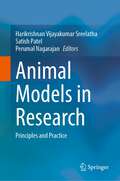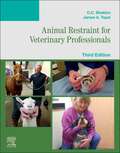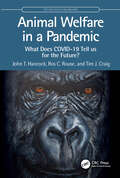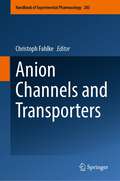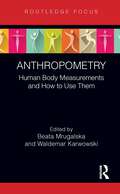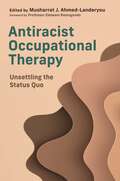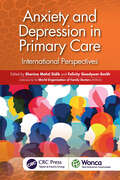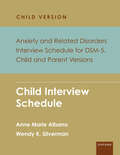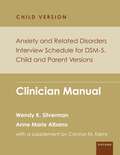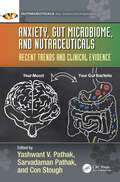- Table View
- List View
Animal Models in Research: Principles and Practice
by Harikrishnan Vijayakumar Sreelatha Satish Patel Perumal NagarajanThis book describes the development of animal models widely used in biomedical research using step-wise instructions and photographs. Showcasing a wide range of species from zebra fishes, birds, rodents, rabbits, dogs, and pigs, the book includes detailed methodology on how to work with these species and to develop various models. The animal models in neurology including stroke, Alzheimer’s disease, Parkinson’s disease, and Schizophrenia; Animal models in cancer research, sleep disorders, and cardiovascular diseases are described to meet the understanding of researchers who plan to replicate these models in their laboratories. In depth detailing on the development of targeted gene knockouts and transgenics, implantation models that are used in toxicology studies, and pharmacokinetic studies in pigs and dogs are a highlight. Further, the book describes pharmacologic, chemically induced, surgically induced, microbiologically induced, infectious models, models for neurobehavioral studies, oncology research, and pain research. The book has dedicated sections on anesthesia and analgesia and teaches procedures like venous cut-downs and cannulations in pigs and dogs, and endotracheal intubation, mechanical ventilation and thoracotomy in rodents and will serve as a self-training tool. Concepts in the field of animal model development are explained using examples. Sample size selection, study design, and statistical evaluation of experiments involving laboratory animals are explained to enable young researchers to practically understand the nuances. This book will be a valuable tool for academicians, students, scientists, and veterinarians and will benefit equally who are new to the field and who are already working with laboratory animals.
Animal Restraint for Veterinary Professionals - E-Book: Animal Restraint for Veterinary Professionals - E-Book
by C. C. Sheldon James TopelMaster proven techniques for the handling and restraint of common animals! Providing clear guidelines to each procedure, Animal Restraint for Veterinary Professionals, 3rd Edition includes photos showing the exact steps needed to achieve safe restraint of animals seen in the veterinary clinic and visited on farm calls. Separate chapters are devoted to each domestic animal species, including cats, dogs, cattle, horses, sheep, goats, pigs, rabbits, rodents, ferrets, and birds. This edition adds descriptions of new restraint techniques for cats, dogs, and other species. Written by expert veterinary technician instructors C.C. Sheldon, and James A. Topel, this practical guide also includes a chapter on knot tying! Step-by-step guidelines make it easy to understand safe, commonly used restraint procedures, and include alternative restraint techniques for several different species. More than 500 full-color images and a clear, non-technical writing style depict and simplify animal restraint concepts. Comprehensive coverage includes normal and abnormal animal behavior characteristics, precautions, special handling, restraint devices, and descriptions of special restraint techniques for medical procedures such as venipuncture. Restraint Principles chapter summarizes the considerations for proper restraint, animal safety, circumstances for restraint, the effect of restraint on animals, and complications. Knot Tying chapter presents basic types of knots that may be used to safely restrain larger animals. NEW! Additional restraint techniques are included for several species. NEW! Restraint of Cats chapter is updated to include guidelines and photos for the removal of cats from a carrier, examination in a carrier, and examination in a towel on the handler's lap. NEW! Restraint of Dogs chapter is updated to include canine head control using a towel, along with safe techniques for administering intramuscular injections to aggressive dogs including the use of a door as a squeeze area and hip catch. NEW! Learning objectives, chapter outlines, and key terms are added to the beginning of each chapter.
Animal Welfare in a Pandemic: What Does COVID-19 Tell us for the Future? (CRC One Health One Welfare)
by John T. Hancock Ros C. Rouse Tim J. CraigAnimal Welfare in a Pandemic explores the impact of COVID-19 on a wide array of animals, from those in the wild to companion and captive animals. During the height of the pandemic, a range of animals were infected, and many died, but this was hard to predict, even using up-to-date bioinformatics. Lockdowns around the world had, and continue to have, a major effect on animals’ welfare, influencing pet ownership and care, as well as impacting on the work of conservation institutes due to the lack of visitors and funding and lack of tourist presence in the wild which impacted on anti-poaching efforts. Some of the vast amount of personal protection equipment (PPE) that was distributed was discarded, creating both dangers and occasional opportunities for wild animals. With the rollout of human vaccines, some countries started developing animal vaccines, only some of which were deployed. In summary, the pandemic had a wide-ranging influence on animal welfare around the world. This is reviewed to highlight what can be learned to protect and enhance animal welfare in future epidemics/pandemics, and contribute to a genuinely One Health approach where the health and welfare of both humans and animals are considered holistically.This book is authored by members of the University of the West of England, Bristol, who span a range of expertise in Biological Sciences, Social Sciences, Animal Welfare, and Ethics.
Animal Welfare in a Pandemic: What Does COVID-19 Tell us for the Future? (CRC One Health One Welfare)
by John T. Hancock Ros C. Rouse Tim J. CraigAnimal Welfare in a Pandemic explores the impact of COVID-19 on a wide array of animals, from those in the wild to companion and captive animals. During the height of the pandemic, a range of animals were infected, and many died, but this was hard to predict, even using up-to-date bioinformatics. Lockdowns around the world had, and continue to have, a major effect on animals’ welfare, influencing pet ownership and care, as well as impacting on the work of conservation institutes due to the lack of visitors and funding and lack of tourist presence in the wild which impacted on anti-poaching efforts. Some of the vast amount of personal protection equipment (PPE) that was distributed was discarded, creating both dangers and occasional opportunities for wild animals. With the rollout of human vaccines, some countries started developing animal vaccines, only some of which were deployed. In summary, the pandemic had a wide-ranging influence on animal welfare around the world. This is reviewed to highlight what can be learned to protect and enhance animal welfare in future epidemics/pandemics, and contribute to a genuinely One Health approach where the health and welfare of both humans and animals are considered holistically.This book is authored by members of the University of the West of England, Bristol, who span a range of expertise in Biological Sciences, Social Sciences, Animal Welfare, and Ethics.
Anion Channels and Transporters (Handbook of Experimental Pharmacology #283)
by Christoph FahlkeThis book provides an overview on recent progress in anion channels and transporters. It covers multiple scales of analysis ranging from studying the molecular basis of function at atomic resolution to cellular consequences to channel/transporter dysfunction and approaches to correct such processes by pharmacological intervention. Similar anion channels and transporters are expressed in multiple tissues – often fulfilling similar cellular tasks, but also clearly distinct functions. The aim is to combine work on multiple cell and organ systems.
Anna O
by Matthew BlakeANNA O – THE WORLD WILL KNOW HER NAME ‘Certain to be one of the year's best thrillers’ LEE CHILD 'Reads like a dream but unsettles like a nightmare' A J FINN
Anterior Controllable Antedisplacement and Fusion (ACAF): Technique in Spinal Surgery
by China Science Publishing & Media LtdAnterior controllable antedisplacement and fusion (ACAF) is becoming globally regarded as the go-to operative technique for the treatment of ossification of spine ligaments (OSL). Suitable for spinal surgeons and rehabilitation physicians at all levels, this timely reference can help make the surgical intervention of OSL much safer, easier, and more effective. It offers thorough case presentations and discussions on the application of ACAF in the treatment of OSL, ossification of posterior longitudinal ligament (OPLL), ossification of ligamentum flavum (OLF), and spinal stenosis. Describes how to successfully complete an ACAF operation, including surgical instruments, techniques, procedures, and associated key tips. Presents typical clinical cases and covers post-operative rehabilitation of ossification of the posterior longitudinal ligament of cervical spine and cervical spinal canal stenosis. Offers systematic discussions of the clinical and theoretical sources of ACAF technology, and clearly describes the process and details of this technology. Reviews past treatment methods of ACAF-related cervical diseases and the evolution of cervical surgery. Consolidates today's available information on this timely topic into a single, convenient resource.
Anthropometry: Human Body Measurements and How to Use Them (Body of Knowledge in Human Factors and Ergonomics)
by Beata Mrugalska Waldemar KarwowskiToday, human factors and ergonomics professionals worldwide contribute to the design and evaluation of tasks, jobs, products, environments, and systems in order to make them compatible with the needs, abilities, and limitations of people. By understanding anthropometry, professionals can ensure that our home and working environments are comfortable and designed with the human in mind. This book aims to show how an understanding of anthropometrics can influence workspace design, ergonomics in the office, ergonomics in the home, and health and safety at work. This book discusses the measurement of the human body and human variability. Anthropometry may seem to be relatively simple but the reality is that it focuses on very sophisticated aspects of how to make the products tailor-made to suit specific requirements. As a study, it is useful for a variety of purposes such as workspace design, ergonomics in the office, ergonomics in the home, and health and safety at work. These eleven chapters investigate anthropometrics and bridge the gap between theory and practice. Each chapter is supported by tables, charts, and illustrations, and a wide list of bibliographic references. The reader will develop new insights into the principles and practice of anthropometrics with this book bringing the topic right up to date. Anthropometry: Human Body Measurements and How to Use Them will be of interest to students, graduates, teachers, researchers, and general workers in industrial design, ergonomics, rehabilitation, safety, and health.
Anthropometry: Human Body Measurements and How to Use Them (Body of Knowledge in Human Factors and Ergonomics)
by Beata Mrugalska Waldemar KarwowskiToday, human factors and ergonomics professionals worldwide contribute to the design and evaluation of tasks, jobs, products, environments, and systems in order to make them compatible with the needs, abilities, and limitations of people. By understanding anthropometry, professionals can ensure that our home and working environments are comfortable and designed with the human in mind. This book aims to show how an understanding of anthropometrics can influence workspace design, ergonomics in the office, ergonomics in the home, and health and safety at work. This book discusses the measurement of the human body and human variability. Anthropometry may seem to be relatively simple but the reality is that it focuses on very sophisticated aspects of how to make the products tailor-made to suit specific requirements. As a study, it is useful for a variety of purposes such as workspace design, ergonomics in the office, ergonomics in the home, and health and safety at work. These eleven chapters investigate anthropometrics and bridge the gap between theory and practice. Each chapter is supported by tables, charts, and illustrations, and a wide list of bibliographic references. The reader will develop new insights into the principles and practice of anthropometrics with this book bringing the topic right up to date. Anthropometry: Human Body Measurements and How to Use Them will be of interest to students, graduates, teachers, researchers, and general workers in industrial design, ergonomics, rehabilitation, safety, and health.
Antiblackness and Global Health: A Response to Ebola in the Colonial Wake (Anthropology, Culture and Society)
by Lioba Hirsch‘A compelling account of how antiblackness and colonialism maintain a grip on the infrastructure of global health, showing us where to aim the hammer in our efforts to knock them off’—Seye Abimbola, University of Sydney‘Reveals the faultlines of inequality and racism in global health formed by colonialism and how they continue to shape global public health practice. A must read’—Rashida Ferrand, Director, The Health Research Unit Zimbabwe‘A compelling and original account linking antiblackness to the coloniality of contemporary global health practice, and the racial politics of care during a public health emergency’—Adia Benton, author of HIV ExceptionalismThis major new account of the 2014–2016 West African Ebola crisis offers a radical perspective on the racial politics of global health. Lioba Hirsch traces the legacies of colonialism across the landscape of global health in Sierra Leone, showing how this history underpinned the international response to Ebola. The book moves from the material and atmospheric traces of colonialism and enslavement in Freetown, to the forms of knowledge presented in colonial archives and in contemporary expert accounts, to disease control and care practices. As the Covid-19 pandemic has revealed, health inequalities around the world disproportionately affect people of African descent. This book aims to equip critical scholars, medical and humanitarian practitioners, policy makers and health activists with the tools and knowledge to challenge antiblackness in global health practice and politics.Lioba Hirsch is a Wellcome Research Fellow and Lecturer in Social Anthropology at the University of Edinburgh.
Antimicrobial Photodynamic Therapy: Concepts and Applications
Antimicrobial Photodynamic Therapy: Concepts and Applications explores the novel antimicrobial therapeutic technique. As the world searches for new, efficient modalities for fighting microorganisms, this book offers a complete understanding of the concept, and knowledge about the emerging technique ‘antimicrobial photodynamic therapy’ (aPDT) for the scientific communities and budding researchers. The book aligns concepts, significance, and applications of the technique systematically. Chapters in the book cover microorganisms, pathogenesis, conventional treatment methods, and significance of new treatment approaches to the concept of antimicrobial photodynamic therapy. The authors describe the mechanism behind it, with applications and examples from research studies. The book discusses photosensitisers in detail, with one chapter emphasising natural photosensitisers. Use of nanostructures in the antimicrobial photodynamic therapy is elaborated on, and we conclude with a well-explored application of the therapeutic technique in dentistry. Features: Efficiently covers the topic in detail with scientifically proven examples. Applications of the therapeutic approach are well discussed, and readers can learn about the research gaps, challenges, and future of the technique. Starts from basics, enabling readers to understand why the approach is relevant and important for study. Simplistic elucidated concepts and applications make it accessible at all levels.
Antimicrobial Photodynamic Therapy: Concepts and Applications
by Siddhardha Busi Ram PrasadAntimicrobial Photodynamic Therapy: Concepts and Applications explores the novel antimicrobial therapeutic technique. As the world searches for new, efficient modalities for fighting microorganisms, this book offers a complete understanding of the concept, and knowledge about the emerging technique ‘antimicrobial photodynamic therapy’ (aPDT) for the scientific communities and budding researchers. The book aligns concepts, significance, and applications of the technique systematically. Chapters in the book cover microorganisms, pathogenesis, conventional treatment methods, and significance of new treatment approaches to the concept of antimicrobial photodynamic therapy. The authors describe the mechanism behind it, with applications and examples from research studies. The book discusses photosensitisers in detail, with one chapter emphasising natural photosensitisers. Use of nanostructures in the antimicrobial photodynamic therapy is elaborated on, and we conclude with a well-explored application of the therapeutic technique in dentistry. Features: Efficiently covers the topic in detail with scientifically proven examples. Applications of the therapeutic approach are well discussed, and readers can learn about the research gaps, challenges, and future of the technique. Starts from basics, enabling readers to understand why the approach is relevant and important for study. Simplistic elucidated concepts and applications make it accessible at all levels.
Antimicrobials in Agriculture (Current Trends in Antimicrobial Research)
by Ram Prasad Arti GuptaThis book offers comprehensive coverage of all manifestations of resistance in combating infectious diseases and explores advances in antimicrobials in agriculture and their applications in the fight against microbes. According to the World Health Organization, antimicrobial resistance is a major threat to global health because the number of alternative antibiotics is very limited. Antimicrobial resistance is a slow, evolutionary process that has been accelerated by human activities in the health, environment, and agriculture sectors. Due to their wide application, antibiotics and their residues have been found in almost all food products and natural ecosystems. This book appraises the drivers, impact, and mitigation of antimicrobials, with a focus on methods and targets. In addition, it also provides a variety of photographs, diagrams, and tables to help illustrate the material. The novel strategies to combat antimicrobial resistance are also described, emphasizing collaborative measures of control. The underlying molecular mechanisms, which depend not only on the microbe but on the specific drug molecule, are highly diverse and are covered in detail.Students, researchers, scientists, practitioners, academicians, biologists, microbiologists, stakeholders, and policymakers can benefit from current trends in antimicrobials in agriculture that address microbiology, microbial biotechnology, ethnopharmacology, toxicology, natural medicinal plant products, secondary metabolites, and all disciplines related to antimicrobial research.Features of the book: Covers antimicrobials in agriculture with up-to-date research Recent references on plausible antimicrobials in agriculture Public health impact of the use of antibiotics in agriculture Antimicrobial efficacy of medicinal plants Role of phytoalexins in agriculture Nanoparticles as antimicrobial agents Presents cutting-edge research on microbiology, nanotechnology, and emergent antimicrobial technologies
Antimicrobials in Agriculture (Current Trends in Antimicrobial Research)
This book offers comprehensive coverage of all manifestations of resistance in combating infectious diseases and explores advances in antimicrobials in agriculture and their applications in the fight against microbes. According to the World Health Organization, antimicrobial resistance is a major threat to global health because the number of alternative antibiotics is very limited. Antimicrobial resistance is a slow, evolutionary process that has been accelerated by human activities in the health, environment, and agriculture sectors. Due to their wide application, antibiotics and their residues have been found in almost all food products and natural ecosystems. This book appraises the drivers, impact, and mitigation of antimicrobials, with a focus on methods and targets. In addition, it also provides a variety of photographs, diagrams, and tables to help illustrate the material. The novel strategies to combat antimicrobial resistance are also described, emphasizing collaborative measures of control. The underlying molecular mechanisms, which depend not only on the microbe but on the specific drug molecule, are highly diverse and are covered in detail.Students, researchers, scientists, practitioners, academicians, biologists, microbiologists, stakeholders, and policymakers can benefit from current trends in antimicrobials in agriculture that address microbiology, microbial biotechnology, ethnopharmacology, toxicology, natural medicinal plant products, secondary metabolites, and all disciplines related to antimicrobial research.Features of the book: Covers antimicrobials in agriculture with up-to-date research Recent references on plausible antimicrobials in agriculture Public health impact of the use of antibiotics in agriculture Antimicrobial efficacy of medicinal plants Role of phytoalexins in agriculture Nanoparticles as antimicrobial agents Presents cutting-edge research on microbiology, nanotechnology, and emergent antimicrobial technologies
Antiracist Occupational Therapy: Unsettling the Status Quo
by VariousSocial justice, inclusion, and person-centredness are the cornerstones of occupational therapy but despite this, the experiences and inequities faced by Black and minoritised populations in health and social care often go unseen and unattended in occupational therapy practice.This timely book provides a compendium of global insights into the inequities faced by Black and minoritised groups in health and social care and considers how key changes in occupational therapy practice and education can redress disparities. Each contributor is active in the occupational therapy community and is incredibly well placed to provide guidance and practical suggestions on how to create sustainable, antiracist practice and disrupt the current status quo.Invaluable to occupational therapy professional bodies, academics, and students alike, this expansive collection of voices is essential reading for those looking to redress the imbalance of power caused by racism.
Antivaccination and Vaccine Hesitancy: A Professional Guide to Foster Trust and Tackle Misinformation
by Thomas AechtnerThis important book provides a comprehensive guide to understanding vaccine hesitancy, as well as the nuances of antivaccination claims. It is designed to give clinicians and other professionals targeted information to help them address vaccine hesitancy and antivaccination claims, as well as ways of responding to immunisation concerns. Alongside the scientific facts around vaccinations, it considers the historical foundations of modern vaccine scepticism, while offering key insights into the psychology behind vaccine hesitancy and the factors which influence an individual’s decision-making. Separating fact from fiction, the book explores the most well-known antivaccine myths, many of which proliferate online, uncovering ways that counter-vaccine narratives can influence audiences. Importantly, it also outlines the most effective strategies to address both doubts and misinformation, detailing five general principles to improve communications, with tips and guidance to debunk false claims or provide assurance in the face of immunisation doubts. This is essential reading for anyone wishing to really understand the phenomenon of vaccine hesitancy, whether professional, student or general reader, and the methods that can be used to challenge misinformation.
Antivaccination and Vaccine Hesitancy: A Professional Guide to Foster Trust and Tackle Misinformation
by Thomas AechtnerThis important book provides a comprehensive guide to understanding vaccine hesitancy, as well as the nuances of antivaccination claims. It is designed to give clinicians and other professionals targeted information to help them address vaccine hesitancy and antivaccination claims, as well as ways of responding to immunisation concerns. Alongside the scientific facts around vaccinations, it considers the historical foundations of modern vaccine scepticism, while offering key insights into the psychology behind vaccine hesitancy and the factors which influence an individual’s decision-making. Separating fact from fiction, the book explores the most well-known antivaccine myths, many of which proliferate online, uncovering ways that counter-vaccine narratives can influence audiences. Importantly, it also outlines the most effective strategies to address both doubts and misinformation, detailing five general principles to improve communications, with tips and guidance to debunk false claims or provide assurance in the face of immunisation doubts. This is essential reading for anyone wishing to really understand the phenomenon of vaccine hesitancy, whether professional, student or general reader, and the methods that can be used to challenge misinformation.
Anxiety and Depression in Primary Care: International Perspectives (WONCA Family Medicine)
by Sherina Mohd Sidik Felicity Goodyear-SmithThis book provides practical information about depression and anxiety in primary care, with a focus on the approach in different countries and incorporating global ranges/prevalence, risk factors and health burden including that associated with COVID-19 and its pandemic. To ensure the challenges of a wide international primary care community are reflected fully, authors from different world regions – Africa, Asia Pacific, East Mediterranean, Europe, IberoAmericana-CIMF, North America and South Asia – have co-contributed to individual chapters on the detection and management of depression and anxiety in primary care in their own countries, including the screening tools used, how widely these tools are adopted and by whom, and current policies. As well as the medical model, it also presents the alternative viewpoint that feeling low or anxious is part of the human condition and the attention should be on supporting people in their journey through life, struggling to deal with the mainly social challenges they meet, rather than defining these problems as disorders or diseases requiring identification and treatment. Key Features: Explores the instruments used for the detection of depression and anxiety in primary care in various countries, and why and how these instruments are being used Describes the pharmaceutical and non-drug interventions for treating depression and anxiety in primary care and compares the similarities and differences in detecting and managing depression and anxiety in primary care among different countries Includes in-depth regional examples of how screening tools are used in practice and how policies can be established in the management of depression and anxiety in primary care Concludes with lessons learned from various countries and from different stakeholders with clear advice on what to do and, importantly, what not to do Addressing primary care detection and management of mental health issues across the globe, the book will be an invaluable practical aid for family medicine practitioners and the wider primary and community care teams and a useful reference for those involved in policy setting at regional and national levels including ministries of health.
Anxiety and Depression in Primary Care: International Perspectives (WONCA Family Medicine)
by Sherina Mohd Sidik Felicity Goodyear-SmithThis book provides practical information about depression and anxiety in primary care, with a focus on the approach in different countries and incorporating global ranges/prevalence, risk factors and health burden including that associated with COVID-19 and its pandemic. To ensure the challenges of a wide international primary care community are reflected fully, authors from different world regions – Africa, Asia Pacific, East Mediterranean, Europe, IberoAmericana-CIMF, North America and South Asia – have co-contributed to individual chapters on the detection and management of depression and anxiety in primary care in their own countries, including the screening tools used, how widely these tools are adopted and by whom, and current policies. As well as the medical model, it also presents the alternative viewpoint that feeling low or anxious is part of the human condition and the attention should be on supporting people in their journey through life, struggling to deal with the mainly social challenges they meet, rather than defining these problems as disorders or diseases requiring identification and treatment. Key Features: Explores the instruments used for the detection of depression and anxiety in primary care in various countries, and why and how these instruments are being used Describes the pharmaceutical and non-drug interventions for treating depression and anxiety in primary care and compares the similarities and differences in detecting and managing depression and anxiety in primary care among different countries Includes in-depth regional examples of how screening tools are used in practice and how policies can be established in the management of depression and anxiety in primary care Concludes with lessons learned from various countries and from different stakeholders with clear advice on what to do and, importantly, what not to do Addressing primary care detection and management of mental health issues across the globe, the book will be an invaluable practical aid for family medicine practitioners and the wider primary and community care teams and a useful reference for those involved in policy setting at regional and national levels including ministries of health.
Anxiety and Related Disorders Interview Schedule for DSM-5, Child and Parent Version: Child Interview Schedule - 5 Copy Set (PROGRAMS THAT WORK)
by Anne Marie Albano Wendy K. SilvermanThe Anxiety Disorders Interview Schedule for DSM-5, Child and Parent Versions, are the gold standard semi-structured interviews used in clinical research and services to assess and diagnose the major mental health conditions affecting children, adolescents and young adults. These interviews cover the range of conditions identified in the Diagnostic and Statistical Manual of Mental Disorders (DSM), while also providing information for careful case formulation in treatment planning and evaluation of outcomes. Evaluators are able to quantify the severity of illness using a Clinician Severity Rating (CSR), as well as level of severity of symptoms and associated avoidance behavior. Decision rules for combining parent and youth reports, examples of CSR levels for the child anxiety triad of separation anxiety disorder, social anxiety disorder, and generalized anxiety disorder are included in the Clinician Guide. Price is for a set of 5 Child Interview Schedules.
Anxiety and Related Disorders Interview Schedule for DSM-5, Child and Parent Version: Clinician Manual (PROGRAMS THAT WORK)
by Wendy K. Silverman Anne Marie AlbanoThe Anxiety Disorders Interview Schedule for DSM-5, Child and Parent Versions, are the gold standard semi-structured interviews used in clinical research and services to assess and diagnose the major mental health conditions affecting children, adolescents and young adults. These interviews cover the range of conditions identified in the Diagnostic and Statistical Manual of Mental Disorders (DSM), while also providing information for careful case formulation in treatment planning and evaluation of outcomes. Evaluators are able to quantify the severity of illness using a Clinician Severity Rating (CSR), as well as level of severity of symptoms and associated avoidance behavior. Decision rules for combining parent and youth reports, examples of CSR levels for the child anxiety triad of separation anxiety disorder, social anxiety disorder, and generalized anxiety disorder are included in the Clinician Guide, as well as detailed information on use of the Autism Supplement. This item includes one Clinician Manual.
Anxiety as Vibration: A Psychosocial Cartography (Studies in the Psychosocial)
by Ana C. MinozzoThis open access book draws on the work of Deleuze and Guattari alongside Lacan and Freud to offer a radical psychosocial survey of the status of anxiety. Taking a multidisciplinary approach, the book examines key issues in contemporary diagnosis and points towards possibilities for forging a more creative clinic. Departing from a feminist, non-Oedipal positioning towards psychoanalytic texts, the author invites art theory, medical humanities and philosophy into a conversation that seeks to answer the question: What can anxiety do? Here, Ana Minozzo explores the possibilities of an encounter with the Real as a sphere of excessive affect in psychoanalysis, and terms this meeting a ‘vibration’. Situating this enquiry within the art practice of Lygia Clark, the book utilises vibration as a conceptual artifice when considering affects, their ethical horizons and a psychoanalytic possibility for creating new ways of living. This book offers exciting new perspective on anxiety for students, clinical trainees, art and humanities researchers and practitioners and those interested in psychoanalytic ideas in general.
Anxiety Disorders and Related Conditions: Conceptualization and Treatment from Psychodynamic and Cognitive Behavioral Perspectives
by Christos Charis Georgia PanayiotouThe volume aims to instigate a dialog between the psychoanalytic and the cognitive-behavioral tradition on conceptualization and treatment of anxiety disorders and related conditions through contributions of respective experts. It presents current findings, and current theories and conceptualizations with regards to the mechanisms of etiology and maintenance of anxiety and related conditions, as well as innovative, new or experimental approaches to treatment that target core difficulties found in patients with anxiety. The book integrates basic research with conceptualization and treatment, while giving space for multiple perspectives to treatment, both psychotherapeutic and pharmacological, to be described. Chapters include a) conceptualization and treatment of anxiety and panic from psychodynamic perspectives, b) 2nd wave CBT treatment and the use of virtual reality, c) 3rd wave (ACT) perspectives, and d) neuroendocrine factors, and e) pharmacotherapy perspectives. Different theoretical approaches are presented highlighting the strengths and the evidence in favour of each approach, without promoting any specific perspective, but with an effort to highlight common underlying themes like safety behaviors and avoidance, social support, and role of learning history. In this way the book will present a combination of theory, science and practice aiming to be an excellent resource for researchers, clinicians and students of mental health professions.
Anxiety, Gut Microbiome, and Nutraceuticals: Recent Trends and Clinical Evidence (Nutraceuticals)
by Yashwant V. Pathak Sarvadaman Pathak Con StoughHealthy gut function is associated with normal central nervous system (CNS) function. Hormones, neurotransmitters, and immunological factors released from the gut are known to send signals to the brain either directly or via autonomic neurons. Recently, studies have emerged focusing on variations in the microbiome and the effect on various CNS disorders, including, but not limited to anxiety, depressive disorders, schizophrenia, and autism. Anxiety, Gut Microbiome, and Nutraceuticals: Recent Trends and Clinical Evidence is focused on understanding the role of gut microbiomes on anxiety and how it can be treated using various nutraceuticals. It covers recent trends and clinical evidence in application of nutraceuticals in treating anxiety and related disorders.Key Features Explains various factors related to anxiety and anxiety-related disorders including pathophysiological and pharmacological factors Discusses the pharmacology behind anxiety and related disorders Explores the role of gut microbiota and its relationship with anxiety and related disorders Describes different nutraceuticals and classes of nutraceuticals which can be useful to treat anxiety and related disorders In recent years, there has been an increased interest in nutraceuticals and their applications in treating many diseases and disorders. The market has grown tremendously, and this book focuses on the many clinical studies reporting on the usefulness of nutraceuticals in treating such health conditions.
Anxiety, Gut Microbiome, and Nutraceuticals: Recent Trends and Clinical Evidence (Nutraceuticals)
by Yashwant V. Pathak, Sarvadaman Pathak, and Con StoughHealthy gut function is associated with normal central nervous system (CNS) function. Hormones, neurotransmitters, and immunological factors released from the gut are known to send signals to the brain either directly or via autonomic neurons. Recently, studies have emerged focusing on variations in the microbiome and the effect on various CNS disorders, including, but not limited to anxiety, depressive disorders, schizophrenia, and autism. Anxiety, Gut Microbiome, and Nutraceuticals: Recent Trends and Clinical Evidence is focused on understanding the role of gut microbiomes on anxiety and how it can be treated using various nutraceuticals. It covers recent trends and clinical evidence in application of nutraceuticals in treating anxiety and related disorders.Key Features Explains various factors related to anxiety and anxiety-related disorders including pathophysiological and pharmacological factors Discusses the pharmacology behind anxiety and related disorders Explores the role of gut microbiota and its relationship with anxiety and related disorders Describes different nutraceuticals and classes of nutraceuticals which can be useful to treat anxiety and related disorders In recent years, there has been an increased interest in nutraceuticals and their applications in treating many diseases and disorders. The market has grown tremendously, and this book focuses on the many clinical studies reporting on the usefulness of nutraceuticals in treating such health conditions.
